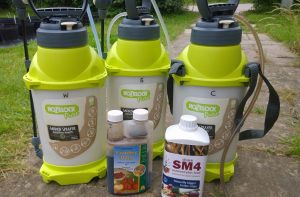Tubs, hanging baskets and window boxes are great ways to introduce additional flowers into gardens. However, the nutrients in container growing media normally only last around six weeks, after which nutrient deficiency can result in stunted growth and poor flowering, potentially limiting the quantity and quality of nectar and pollen available to bees.
The application of foliar feeds enables the quick, short-term supplementation of micro and macronutrients essential for healthy plant growth, as well as biostimulants which promote growth. While there have been many studies exploring the value of foliar feeds for commercial horticulture and floriculture, little is known about the effect of foliar feeds in a domestic garden setting or their value for improving floral resource provision for bees.

In order to address this, we conducted a trial in partnership with Hozelock to determine whether foliar feeding container grown nasturtiums could increase 1) plant growth and floral abundance, 2) nectar and pollen quantity and quality, and 3) bee visitation rates. We compared 48 tubs of ‘Ladybird’ nasturtiums, which received a weekly foliar feed of either Agralan comfrey tonic , Chase SM4 seaweed feed or mains tap water (applied using Hozelock’s Pure sprayer), or no foliar feed.
Plant growth and floral abundance
Foliar feeding had no statistically significant effect on plant size, the number of flowers produced, or the visual quality of either flowers or foliage. This was surprising as previous studies have shown that foliar feeding increased plant size, as well as the number of flowers per plant in commercial carnation crops.

Nectar and pollen quantity and quality
Although the flowers from plants receiving the comfrey feed contained, on average a higher nectar sugar content and greater pollen volume, foliar feeding had no statistically significant effect on either. We could find no previous studies examining the effects of foliar feeding on nectar and pollen, but these results were still surprising as there is some evidence that increasing the availability of nutrients using soil amendments can positively affect the quality of both nectar (sugar content) and pollen (protein) in cucumbers.



Bee visitation
The nasturtiums were visited by four species of bumblebee: the Garden Bumblebee (Bombus hortorum), Common Carder Bee (Bombus pascuorum), Buff-tailed Bumblebee (Bombus terrestris) and White-tailed Bumblebee (Bombus lucorum). Although we monitored the nasturtium plants for a total of six hours over four dates, we saw only 35 bumblebees make a total of 261 flower visits, which limited the analysis we were able to perform.

Bombus hortorum

Bombus pascuorum

Bombus terrestris/lucorum
To determine whether foliar feeding affected the attractiveness of the flowers to bumblebees, we compared the length of time bumblebees spent collecting nectar and pollen from the different treatments. Although plants fed with comfrey seemed to be visited for the least amount of time overall, this was found to have no statistically significant effect.

Conclusions and recommendations
It is likely that the effects of foliar feeding vary between plant species, and it is possible that nasturtiums failed to fully absorb the feeds due to the texture of their leaves. It would, therefore be valuable to trial other popular garden plants with easily measured nectar and pollen, such as hardy geraniums (Geranium species), borage (Borago officinalis) and sages (Salvia species). A wider range of commercially available and home-made foliar feeds, applied at varying concentrations could be also trialled to see how they compare.
Despite the lack of significant results in this trial, foliar feeds remain a great way to apply micro and macro-nutrients to give plants a quick pick-me-up. The Hozelock Pure sprayer was of excellent quality, easy to use and should last many growing seasons – we look forward to experimenting further with it in the future.


Find more about what we did by visiting Twitter and Facebook using #HozelockBlooms, and take a look at our blog.

